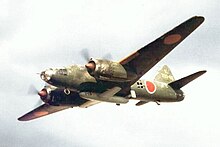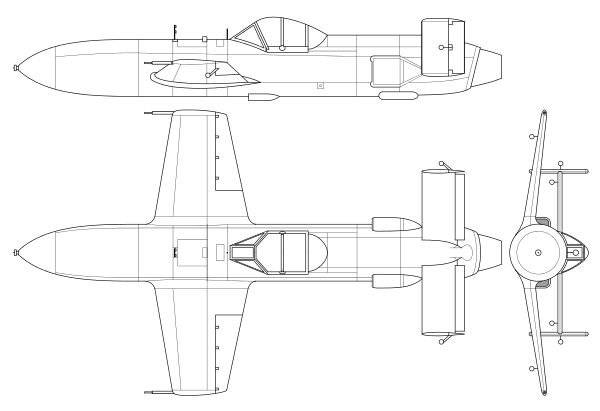Yokosuka MXY-7
The Yokosuka MXY-7 Ohka 桜花 ( cherry blossom?) was a single-use rocket plane, created by Japan exclusively for use by kamikaze suicide pilots near the end of World War II. The American fighters gave him the nickname baka, which in Japanese means fool or stupid.
Features


It was a small manned flying bomb, capable of being transported by a Mitsubishi G4M "Betty" bomber, a Yokosuka P1Y Ginga "French" (Type 22) or by the new Nakajima G8N Renzan "Rita" to the vicinity of its objective. Okha's first group of kamikaze crews were the 721st. based in Takao, Taiwan.
After being released from the guide plane, return was impossible, the pilot had to plan after selecting a target, turn on the three rocket motors one by one and dive against it. The final approach was unstoppable, especially for the Type 11, due to the enormous speed reached, on one occasion passing through the ship from side to side and exploding out of it. Later versions were designed to be launched from coastal bases and caverns, and even from submarines equipped with catapults, although no Ohka were used in this way.
Training was done in a jetless gliding version that had the ability to land using a skid installed on its lower front part. There were single cabin and double cabin versions. If the pilot managed to land, basic training was completed. Communication between the kamikaze pilot and the guide plane was done through a Morse device, the controls were extremely simple, once installed the pilot had no possibility of leaving the cockpit since it was sealed from the outside, the plane could be controlled with a control lever, it did not have a radio, it had a speedometer, compass, horizontality indicator and on its left side it had a button panel that allowed it to ignite the reactors.
The Ohka project could not reach its full deadly potential. The Ohkas had little success on the battlefield, because the bombers carrying them were slow and easy targets for American fighters to shoot down.
The aircraft carrier Shinano on its first and last voyage transported 50 of these rocket ships on its journey from Yokosuka to Kure, the Shinano was sunk on November 29, 1944.
Military effectiveness

Only 7 American ships suffered various damage from the Ohka, among the ships hit by the Ohka were the USS Stanly (DD-478) which was literally pierced from side to side and the USS Mannert L. Abele (DD -733) which was the only American ship actually sunk in the final course of the war by an Okha on April 12, 1945 north of the island of Okinawa with 83 sailors dead.
Legacy in popular culture
The pilots, members of the Jinrai Butai (Thunder God Corps) or the 721 group, are currently honored in Kashima City's Ohka Park, at monuments in Kanoya City, Kamakura (in the Kenchō- ji) and at the Yasukuni Shrine in Tokyo. Yoshinori Kobayashi, one of Japan's most famous mangakas, shows the kamikaze as an example of the values that have been lost in modern Japan.
Types

Operational versions
- Kugisho/Yokosuka MXY-7 "Ohka" Type 11 Suicide attacker powered by rocket. 852 built.
Non-operational versions
- Kugisho/Yokosuka "Ohka" Type 21 Suicide attacker powered by rocket. Steel wings, a copy.
- Kugisho/Yokosuka "Ohka" Type 22 Suicide attacker powered by thermoreactor. 50 built.
- Kugisho/Yokosuka "Ohka" Type 33 Suicide Attacker powered by turboreactor. Version to be released from a G8N.
- Kugisho/Yokosuka "Ohka" Type 43A Ko Suicide Attacker powered by turboreactor. Version to be released from submarines.
- Kugisho/Yokosuka "Ohka" Type 43B Otsu Suicide attacker powered by turboreactor. Version to be released from caves.
- Kugisho/Yokosuka "Ohka" Type 53 Suicide Attacker powered by turboreactor. Tow plan version.
Coaches
- Kugisho/Yokosuka "Ohka" K-1 Suicide Attack Trainer.
- Kugisho/Yokosuka "Ohka" K-1 Kai Suicide Attack Trainer.
Specifications (Type 11)

General characteristics
- Triple: One (pilot)
- Length: 6.1 m (20 ft)
- Scope: 5.1 m (16.7 ft)
- Height: 1.2 m (3.9 ft)
- Elong surface: 6 m2 (64.6 ft2)
- Empty weight: 440 kg (969.8 lb)
- Weight loaded: 2140 kg (4716.6 lb)
- Motriz plant: 3× rockets of propergol solid Type 4 Mark 1 Model 20.
- Normal push: 2.6 kN (265 kgf; 585 lbf) every push.
Performance
- Speed never exceeded (Vne): 1064. km/h
- Maximum operating speed (Vno): 805 km/h (500 MPH; 434 kt) (1040 km/h at the bite with the 3 motors activated)
- Scope in combat: 36 km (19 nmi; 22 mi)
- Long load: 356 kg/m2 (72.9 lb/ft2)
- Push/weight: 0.38
Weapons
- Others:
- Ojiva 1200 kg trinitroaminol
Comparable aircraft
- Bachem Ba 349
- Fieseler Fi 103
- Fieseler Fi 103 Reichenberg (tradition of the V-1, suicide)
- Kawanishi Baika
External references
- ↑ Okha in museum exhibit USA
- ↑ Yokosuka MXY-7 Ohka
- ↑ RAF Museum-Yokosuka MXY7 Ohka
- ↑ Okha Collection Smithsonian Institute
- ↑ Operating History of Shinano
- ↑ Sensouron (On War) by Yoshinori Kobayashi
Bibliographical references
- Hatsuho Naito. Thunder Gods: The Kamikaze Pilots Tell Their Stories. Dell, 1990. ISBN 0-440-20498-4
- S. Nohara. Illustrated Warplane History 8: The Xplanes of Imperial Japanese Army & Navy 1924-45. Green Arrow, Japan 1999. ISBN 4-7663-3292-X